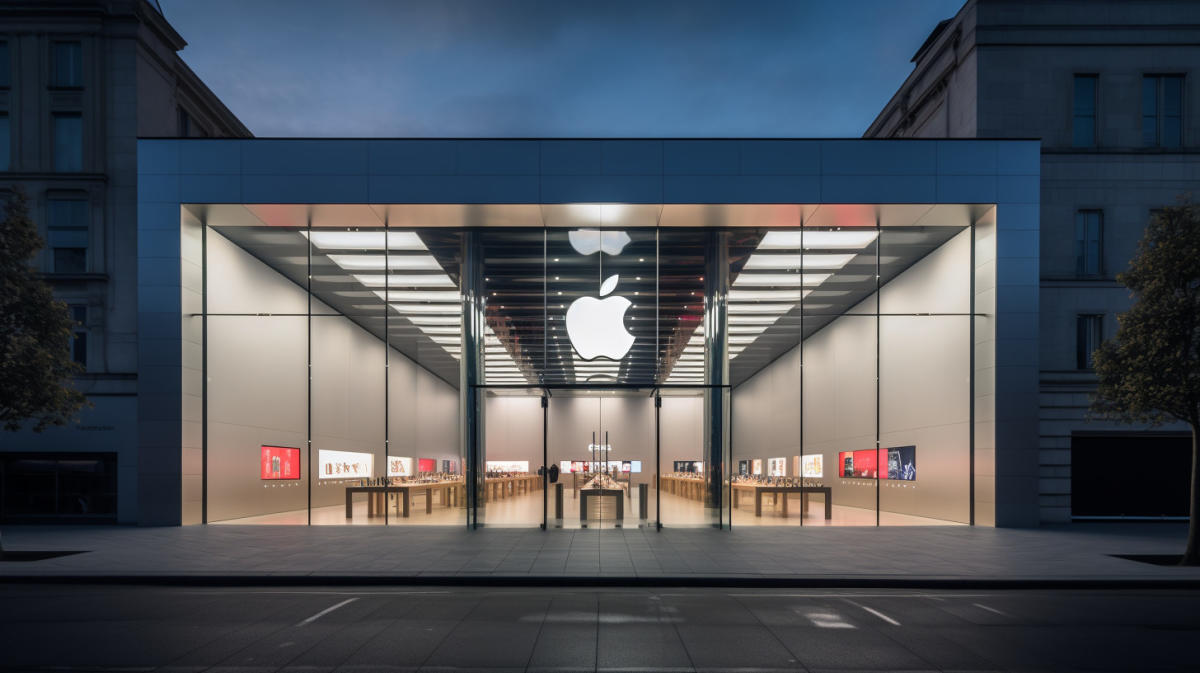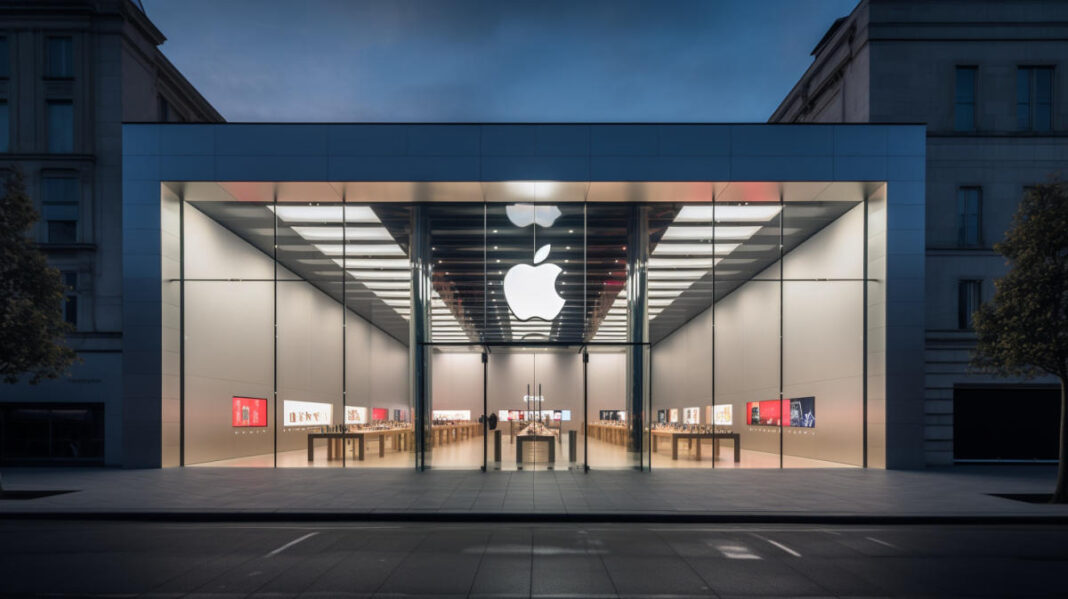## Apple’s Empire on Shaky Ground: Can Services and AI Save the Day?
The tech giant that redefined the smartphone and built an ecosystem of loyal followers is facing a new challenge: tariffs.
Big Apple, beware: analysts are sounding the alarm, slashing price targets as import taxes threaten to squeeze profits. Can Apple’s burgeoning services business and its foray into artificial intelligence be the golden shields against this storm? Or will the tariffs chip away at its once-unassailable market dominance? We delve into the numbers, the strategies, and the future of Apple’s empire in this crucial moment.Apple’s AI Strategy

Apple Inc. (AAPL) is making significant strides in artificial intelligence (AI), strategically integrating AI capabilities across its ecosystem of products and services. While not as vocal as some of its Silicon Valley counterparts, Apple’s approach to AI is characterized by a focus on privacy, seamless user experience, and leveraging AI for enhancing existing functionalities rather than creating entirely new AI-driven products.
Siri and Natural Language Processing
Siri, Apple’s voice assistant, serves as a prime example of Apple’s AI investments. Continuously evolving, Siri leverages natural language processing (NLP) to understand complex user requests, provide context-aware responses, and integrate with a growing number of third-party applications. Apple’s ongoing research in NLP aims to make Siri more conversational, intuitive, and capable of handling nuanced language.
Machine Learning for Enhanced User Experience
Machine learning (ML) is deeply embedded in Apple’s software and hardware, powering a range of features that personalize and optimize the user experience. From intelligent suggestions in the App Store and Spotlight search to personalized recommendations in Apple Music and curated content in Apple TV+, ML algorithms analyze user behavior and preferences to deliver tailored experiences.
Autonomous Systems and the Future
Apple’s foray into autonomous systems is an area of growing interest. While the company has not yet publicly unveiled any autonomous vehicles, its acquisition of companies like Drive.ai and its investments in self-driving technology suggest a strategic interest in this domain. Apple’s expertise in sensor technology, software development, and user interface design positions it well to play a role in the future of autonomous transportation.
Services as a Growth Engine
Faced with slowing hardware sales and mounting pressure from tariffs, Apple is increasingly relying on its subscription-based services to drive revenue growth. These services, which offer recurring revenue streams, are becoming a crucial pillar of Apple’s business model.
Apple Music: A Rising Star in the Streaming Wars
Apple Music, Apple’s music streaming service, has gained significant traction since its launch in 2015. With a vast library of songs, exclusive content, and integration with Apple devices, Apple Music has emerged as a major competitor in the streaming wars, challenging Spotify and Amazon Music.
iCloud: Data Storage and Beyond
iCloud, Apple’s cloud storage service, has become an indispensable part of the Apple ecosystem. Offering secure storage for photos, videos, documents, and other data, iCloud syncs seamlessly across Apple devices. Apple is expanding iCloud’s capabilities beyond storage, incorporating features like iCloud Drive for document collaboration and iCloud Keychain for password management.
Apple TV+: Streaming into the Spotlight
Apple TV+, Apple’s streaming video service, has garnered attention for its original programming, featuring acclaimed shows and movies produced by renowned creators. While still in its early stages, Apple TV+ is investing heavily in content acquisition and production, aiming to attract a wider audience and compete with established streaming giants like Netflix and Disney+.
The Expanding Apple Services Portfolio
Beyond these core services, Apple is continuously expanding its portfolio with offerings like Apple Arcade for mobile gaming, Apple News+ for curated news content, and Apple Fitness+ for guided workouts. This strategic diversification of services aims to create a robust and interconnected ecosystem that caters to a wider range of user needs.
China Market Challenges
The escalating trade war between the United States and China poses significant challenges to Apple’s operations and its ability to compete effectively in the crucial Chinese AI market.
Tariffs and Supply Chain Disruptions
China is a critical manufacturing hub for Apple, and the imposition of tariffs on Chinese goods has increased production costs and created supply chain disruptions. These costs are ultimately passed on to consumers, potentially impacting demand for Apple products in China.
Innovation Under Pressure
The ongoing trade tensions also threaten Apple’s ability to innovate and develop new AI technologies in China. The transfer of intellectual property, collaboration with Chinese research institutions, and access to skilled talent are all factors that could be negatively affected by the trade war.
The Geopolitical Landscape
The trade war is part of a broader geopolitical rivalry between the United States and China, with AI emerging as a key battleground. The potential for increased restrictions on technology exports and collaboration could further hinder Apple’s ability to operate in the Chinese AI market.
Navigating the Storm: Strategies for Survival
Faced with these challenges, Apple is exploring several strategies to mitigate the impact of tariffs and navigate the complexities of the global trade environment.
Diversifying Production
Apple is actively seeking to diversify its manufacturing base beyond China, exploring alternative suppliers and production hubs in countries like India, Vietnam, and Mexico. This move aims to reduce reliance on China and minimize the impact of tariffs.
Lobbying Efforts
Apple is actively involved in trade negotiations and lobbying efforts aimed at mitigating the negative impact of tariffs on its business. The company has lobbied the U.S. government to exclude certain components and products from tariffs, arguing that these measures could harm American consumers and businesses.
Futureproofing Innovation
Apple is investing heavily in research and development to stay ahead in the AI race. The company is developing its own AI chips, exploring new applications for AI in its products and services, and fostering collaborations with AI research institutions worldwide.
Conclusion
Conclusion: Can Apple’s Resilient Services and AI Save It from Tariff-Induced Woes?
As we conclude our analysis of Apple Inc.’s (AAPL) recent struggles due to tariffs, it’s clear that the tech giant faces a perfect storm of challenges. Key points to take away from this article include the significant impact of tariffs on Apple’s profit margins, the company’s decision to absorb some of these costs, and the potential for services and AI to become a key differentiator in the market. Our main argument is that while Apple’s services segment has shown impressive growth, it remains to be seen whether it can fully offset the revenue lost due to tariffs. Additionally, the integration of AI into Apple’s product offerings is a strategic move that could pay off in the long run, but its immediate impact on the company’s financials is uncertain.
The significance of this topic lies in its far-reaching implications for the tech industry as a whole. As one of the world’s largest and most influential companies, Apple’s response to tariffs sets a precedent for other businesses facing similar challenges. The successful integration of services and AI could be a game-changer for Apple, but it also raises questions about the sustainability of this model. Will services and AI be enough to propel Apple forward, or will the company’s reliance on these areas create new vulnerabilities? As we look to the future, one thing is clear: the next chapter in Apple’s story will be shaped by its ability to adapt to an increasingly complex and competitive market.
In the end, Apple’s ability to navigate the treacherous waters of tariffs and emerging technologies will be a defining moment in its history. As the company continues to push the boundaries of innovation, it’s clear that its success will depend on its willingness to take bold risks and invest in the future. Will Apple emerge from this period stronger and more resilient than ever, or will the weight of tariffs and competition prove to be too much to bear? Only time will tell, but one thing is certain: the fate of Apple Inc. will be a closely watched tale of trial and triumph in the annals of business history.
